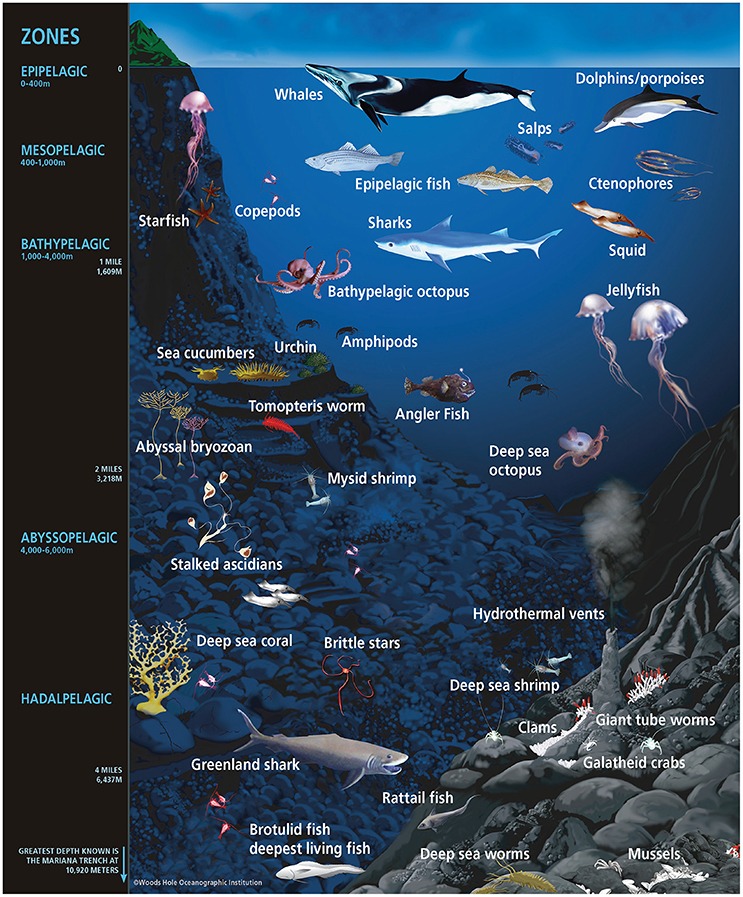Oceans cover over 70% of the Earth’s surface, and contain 97% of our planet’s water. This huge environment, which is still mostly unexplored, is subdivided into various areas with different conditions. Each zone and each layer are their own unique habitat, and their subdivision depends on depth, with conditions changing as pressure increases and light decreases. Here we will only consider the regions of open ocean far from the coast, as coastal habitats are much different.
The first important distinction in the marine habitats is between the benthic zone and the pelagic zone. The benthic zone is the area along the bottom of the sea, while the pelagic zone includes the open water where organisms swim and float. Both the benthic and the pelagic zone are further subdivided into other regions. First of all, the pelagic zone is divided into two areas which depend on the distance from the coast: the neritic zone and the oceanic zone. The neritic zone is the more shallow part of the ocean, which corresponds to the area of the sea above the continental shelf, where the depth of the water is usually less than 200 meters. The oceanic zone is instead the area further from the coast, beyond the continental shelf, and includes around two thirds of the Earth’s oceans.
Diagram showing the different layers in the ocean (K. Aainsqatsi at en.wikipedia, Wikimedia Commons, CC BY-SA 3.0).
The pelagic zone is also divided vertically into different layers, which depend on the depth of the water. The uppermost layer is the photic or epipelagic zone, which includes the area between the surface and a depth of around 200 meters. This is the part of the ocean that receives sunlight, which allows phytoplankton to perform photosynthesis, and also makes this the warmest part of the ocean. For this reason, it is also called sunlight zone. Rich with nutrients, this zone is home to the majority of aquatic life. Here we can find most fish, but also whales, dolphins, sea turtles, and jellyfish. Also, basically all the neritic zone is part of the photic zone.
The next region, between a depth of 200 and 1,000 meters is known as the mesopelagic zone or twilight zone. Only faint sunlight can reach this deep and, due to the lack of light, photosynthesis is impossible and some creatures with bioluminescence start to appear. This is the area with the most extreme temperature changes, and includes the thermocline, a layer of water in which temperature decreases quickly. The upper layers of the mesopelagic zone can have temperatures up to 20 °C, while at the bottom of this zone the temperature goes down to 4 °C. This area hosts a large biological diversity and animals who live here include swordfish, octopuses, giant squids, and various creatures that adapted to the lack of sunlight. All the layers below the photic zone, including the mesopelagic zone, are also collectively known as aphotic zone.
The area between 1,000 and 4,000 meters below the ocean’s surface is the bathypelagic or bathyal zone, also known as midnight zone. Here there is no light at all, bioluminescence is limited, and the temperature remains constantly around 4 °C. This area makes up the majority of the oceans, but due to its depth, the knowledge of this region is still limited. Very few creatures live here, but sharks, squids, octopuses, can be found in this region, while whales sometimes dive down to this level in search for food such as plankton.
Going even deeper, the area between 4,000 and 6,000 meters below the surface is called abyssal or abyssopelagic zone. With no light and no plants, this area has little oxygen but contains a lot of nutrient salts due to the large amount of dead organic material that falls to this zone from the upper layers. The temperature here is between 2 °C and 3 °C, and only a small number of creatures can survive in this region. Most of the organisms who live here are invertebrates, such as sea stars, shrimps, and squids.
The final layer is the hadal or hadopelagic zone. This area, located over 6,000 meters below the surface, only lies in the deepest oceanic trenches, and makes up a tiny fraction of the marine environment. This area includes the deepest point of any ocean on Earth, the Challenger Deep in the Mariana Trench, located in the Pacific Ocean, which reaches a depth of almost 11,000 meters. In the hadal zone the temperature is only slightly above 0 °C, and the pressure can exceed 1,100 standard atmospheres. Despite the extreme conditions, life exists even here, but it is limited to bacteria and some species of invertebrates. This area has only been reached by humans a handful of times and, like most of the deep ocean, is still largely unknown. The benthic zone is also subdivided into layers depending on depth, which correspond to the divisions of the pelagic zone.
Illustration of the animal life that can be found in the different oceanic layers (Amy Apprill, Wikimedia Commons, CC BY-SA 4.0).



